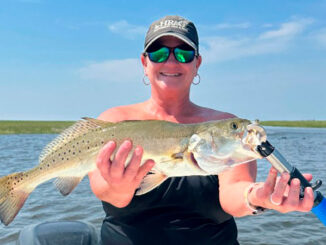
Putting the odds in your favor at these inshore spots is worth the effort
Oil and gas rigs dot our inshore Louisiana lakes and bays. More accurately, the structures we anglers call “rigs” are platforms in industry terms, but since we are all anglers, I will use the term rigs. In a few areas where the oil reserve is large, the inshore rigs are concentrated so 10 main rigs may exist in a five mile radius.
Additionally, many small structures marking well heads surround these main rigs. In most areas, the reserves do not justify more than a few main rigs within a five mile radius, so the distance between rigs is long relative to the distances inshore anglers typically travel between fishing spots.
It is those distances that keep many inshore anglers from focusing on rigs as their primary speckled trout fishing destination.
There was a time when I never considered spending the day fishing inshore rigs, because the drive time verses line time ratio was too high. There is a hopeless feeling that arises when you drive five miles across open water to a rig where you caught speckled trout in the past, and you find nothing but hard-head catfish and snags. Looking around, you can see another rig but that one is also five miles away and will not guarantee you a single speckled trout on any given day. This is the dilemma of fishing inshore rigs.
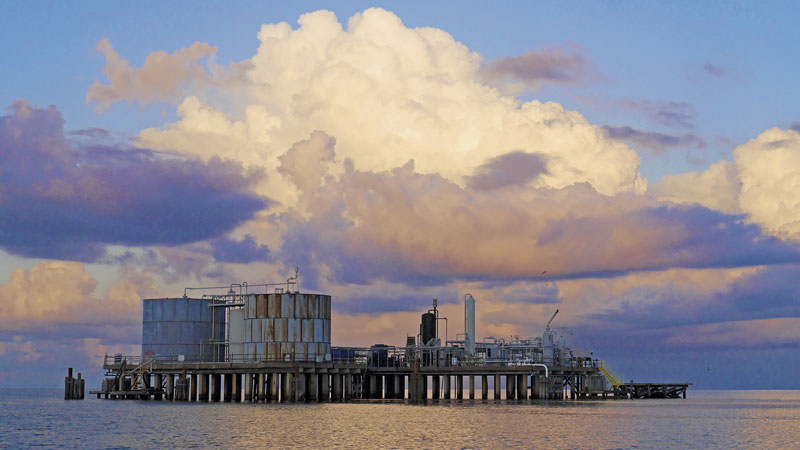
Why bother?
If you are new to fishing rigs, then I suspect you are asking the question, “why should I bother with them?” My simplest response is, for the same reason you fish the Lake Pontchartrain train trestle. If you fish the trestle you know that it attracts large numbers of trout and often some of the biggest trout in that basin, but have you considered that the habitats of productive rigs and the train trestle are very similar?
You also know that trout are most often concentrated along the trestle in the spring and fall, which is the pre and post spawn seasons, because the salinity in Lake Pontchartrain is on average well below the 15 ppt threshold generally considered necessary for successful spawning. Imagine how productive the trestle could be if you moved it into the high salinity water of the Mississippi Sound during the summer. That is basically what the productive inshore rigs offer you during the spawning season. I hope that answers the question of why bother fishing inshore rigs.
Notice that I am referring to productive rigs and not simply rigs, which as you now suspect, not all rigs are productive. Driving halfway across one of our bays to a non-productive rig will surely dampen your enthusiasm for rig fishing.
Therefore, we have to define what makes for a productive rig on an average day. Just like the train trestle, a productive rig provides an oasis of habitat in an aquatic desert. Similar to the train trestle, the productive rigs sit in water with depths around 10 feet.
I do not spend much time with rigs in water less than six feet of depth. The rigs we want have platforms supported by pilings instead of walls and a higher number of smaller pilings instead of massive steel pilings. The more pilings there are, the more cover there is for organisms across all trophic levels. That includes speckled trout, which also need cover to escape dolphins and sharks.
Don’t overthink it
The concept of cover can seem counterproductive from an angler’s perspective, because if a trout’s food has good cover in the habitat, then how will a trout eat there? As big brained organisms, which regularly identify risks and weigh those against rewards, we are overthinking this problem.
The little critters that trout eat are not that smart and regularly leave unprotected cover where they are gobbled up. However, the scientific data is very clear that habitats with good cover, such as reefs, allow enough lower trophic level organisms to evade predation so that a healthy ecosystem is built across all trophic levels.
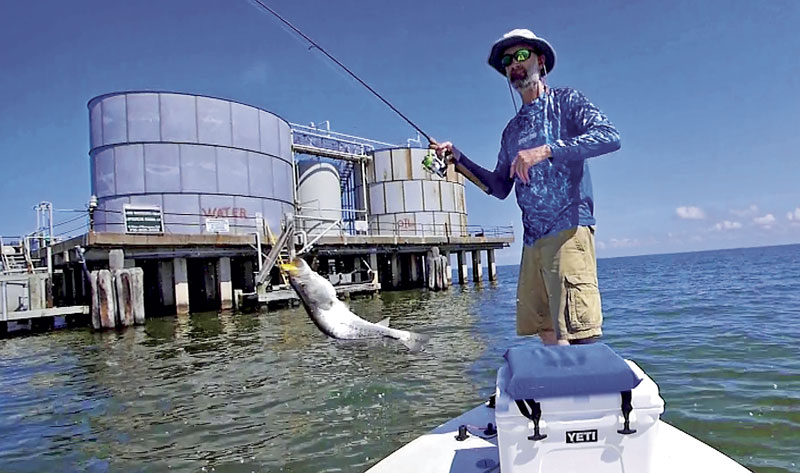
While there are some inshore rigs in deeper, low salinity water, such as one I used to fish in western Lake Pontchartain, most of the good rigs in the areas I fish are closer to the Gulf. This makes them better for speckled trout fishing from late spring until September.
We need to further distill down the definition of a productive rig so that we can see the difference between the ideal and the merely good. First, in my experience there are advantages to certain geometric layouts of rig platforms. I prefer platforms that have pipe rack structures extending out from the main structure or that join two or more main platform sections. This greatly increases the edges we can fish, and fortunately the trout seem to feed on the edges more than inside dense stands of pilings.
I have many times cast baits between pilings to reach deep under a platform with no luck. However, it would be wrong to interpret these observations as evidence that concentrated piling sections are unimportant. In fact, I believe that productive rigs nearly always have at least one section of dense piling stands. As we will see later, the number of pilings can directly impact the overall health of a rig habitat.
What’s it made of?
The materials from which rig platform pilings are constructed also have an impact on the productivity of the rig. On one level, the structural designs change because of material strength, so for instance, fewer pilings are needed when using steel verses wood. That is likely to result in fewer pilings supporting a platform when steel is used, which would negatively impact the productivity by reducing the amount of surface area and cover provided by the rig.
The construction material of the pilings also impacts the type and number of sessile organisms (without the ability to move) which attach to the pilings. These organisms include shellfish, worms, sponges, and more. The shellfish provide filtration of water and cover for smaller organisms, and many of these sessile organisms are food for bait fish and fish consumed by humans.
We understand the value of fishing over oyster beds, and similarly, rig pilings covered with communities of sessile organisms increase the productivity of a rig. Which brings us back to the importance of many pilings in a rig, because the total surface area for sessile organisms is directly related to the number of pilings.
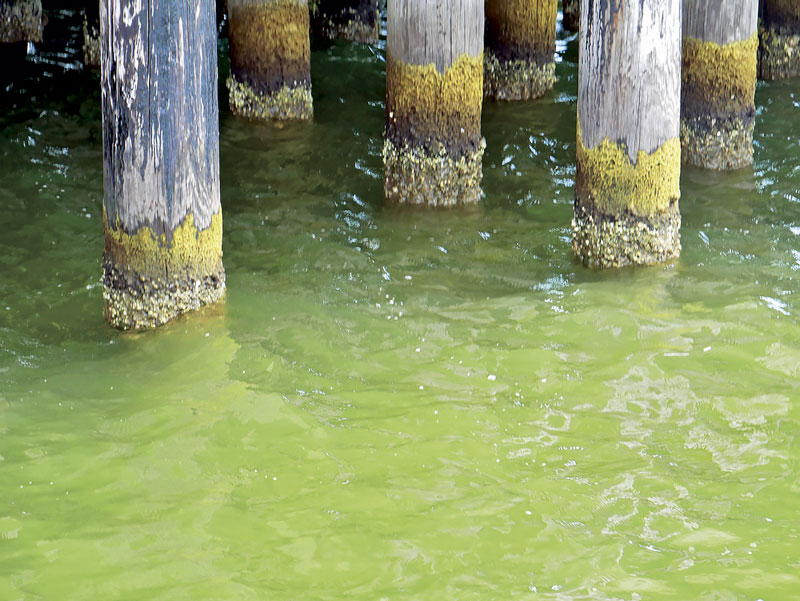
Some piling materials provide a better surface for the sessile organisms than others. A group of researchers did an extensive study in the Loxahatchee River in Florida where they examined dock pilings and recorded the species and numbers of sessile organism for various piling materials. By far the most favorable piling material for sessile communities was concrete followed by wood. Thinking back to the rich habitat of the Lake Pontchartrain train trestle, it should be noted that the trestle has concrete pilings. Our inshore rigs have mostly wood with some steel and concrete. Based on this information, rigs with concrete pilings should at a minimum be investigated for the presence of trout.
Another important question to ask is, “where on a rig should we fish?” If it is Saturday and you are at one of the two rigs on the northeast side of Grand Isle, the answer is, wherever there is an open spot. Congestion of anglers around easily accessible rigs can be a significant problem during some periods, so plan accordingly.
I typically will start on the down current side of the dense set of pilings and then work along the arm structures if they exist. If I do not hit fish on the down current side, I will always check the up current side, because just like on the trestle, trout can stage on either side of a current break. Lastly, rigs typically have shell pads around them, which is another productive structure. Unfortunately the pads often get covered by sediment. Where the pads are not covered, trout will feed across the shells and along their edges. Use a sonar or a heavy jig to discover the condition of the shell pads.
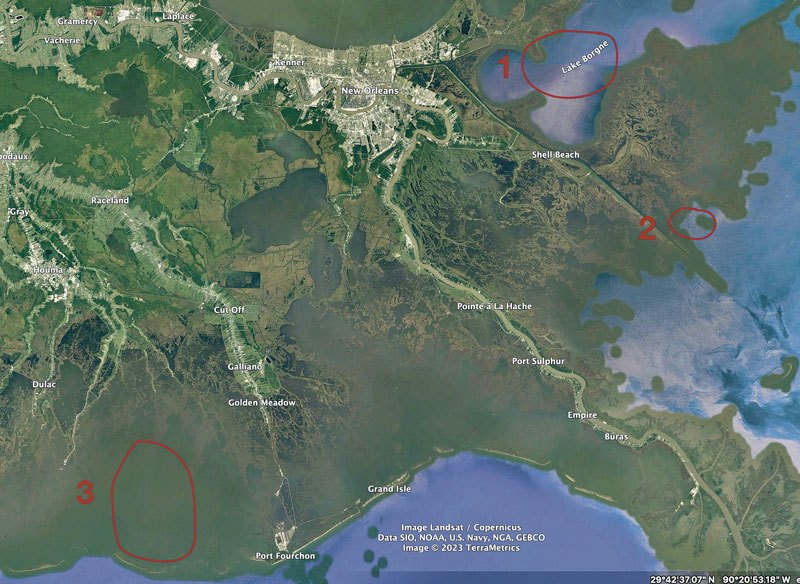
Where to look
Finally, where do concentrations of productive inshore rigs exist in southeast Louisiana?
There are a few rigs close to land which I will treat as just another spot to check on a given day, but when I want to focus on rig fishing, I will go to either Lake Borgne, Bay Eloi or Terrebonne Bay and areas north. The Terrebonne Bay rigs are the farthest from launches, but are highly concentrated, so most of my rig fishing trips I will take to Terrebonne Bay. Beyond starting in a good general area, be prepared to rig hop on every trip until you find concentrations of trout.
I am exclusively an artificial bait angler, but live bait works well around rigs.
Probably the biggest challenge with live bait on corks is getting the bait to where the trout are feeding. Due to large predators, trout are often holding close to or inside a line of pilings and toward the bottom. This means that presenting the bait into this zone can be challenging with a fixed cork rigging. A more efficient delivery is with a sliding cork and a short leader. My first choice in artificial baits is a jig-head and plastic swim-bait such as a Matrix Shad, but I will also throw twitchbaits like a FatBoy or suspending jerkbaits which dive to five or six feet. If you can catch fish along the train trestle, then you can be successful on inshore rigs using the same techniques.
I hope you will give them a try this year.


